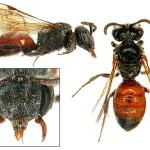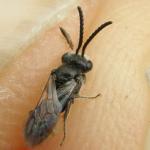Sphecodes bituberculatus PÉREZ 1903; Sphecodes opacifrons PÉREZ 1903
Frequent in southern England, north to Cumberland and Yorkshire, and on the south coast of Wales. Also found in the Channel Islands.
Found in Europe, north Africa and east to central Asia.
This species is not regarded as being scarce or threatened.
Occurs in the same habitats as its hosts and is not particularly ecologically restricted, e.g. can be found in coastal areas, sandy heaths, occasionally in calcareous grassland and also in open woodland such as chestnut coppice.
The female flies from May to October and the male from July to October.
This bee is a cleptoparasite on various Lasioglossum species, particularly L. lativentre (Schenck) and L. quadrinotatum (Kirby). Lasioglossum villosulum (Kirby) and L. brevicorne (Schenck) have also been implicated. There is no further information available on the parasitic biology.
This bee frequently visits Asteraceae, including common fleabane, goldenrod, mayweeds and thistles, for nectar only.
No data available.
2012



